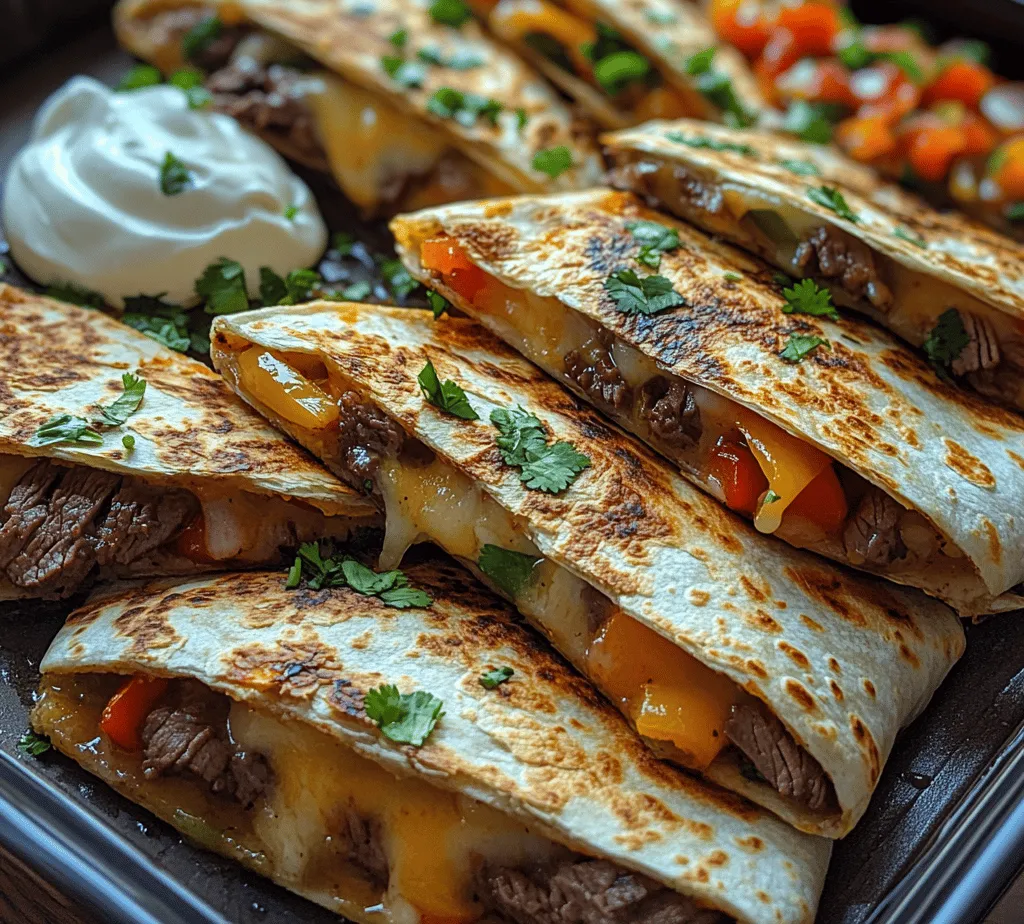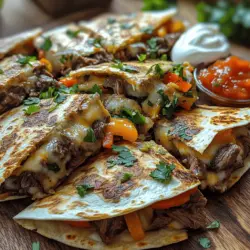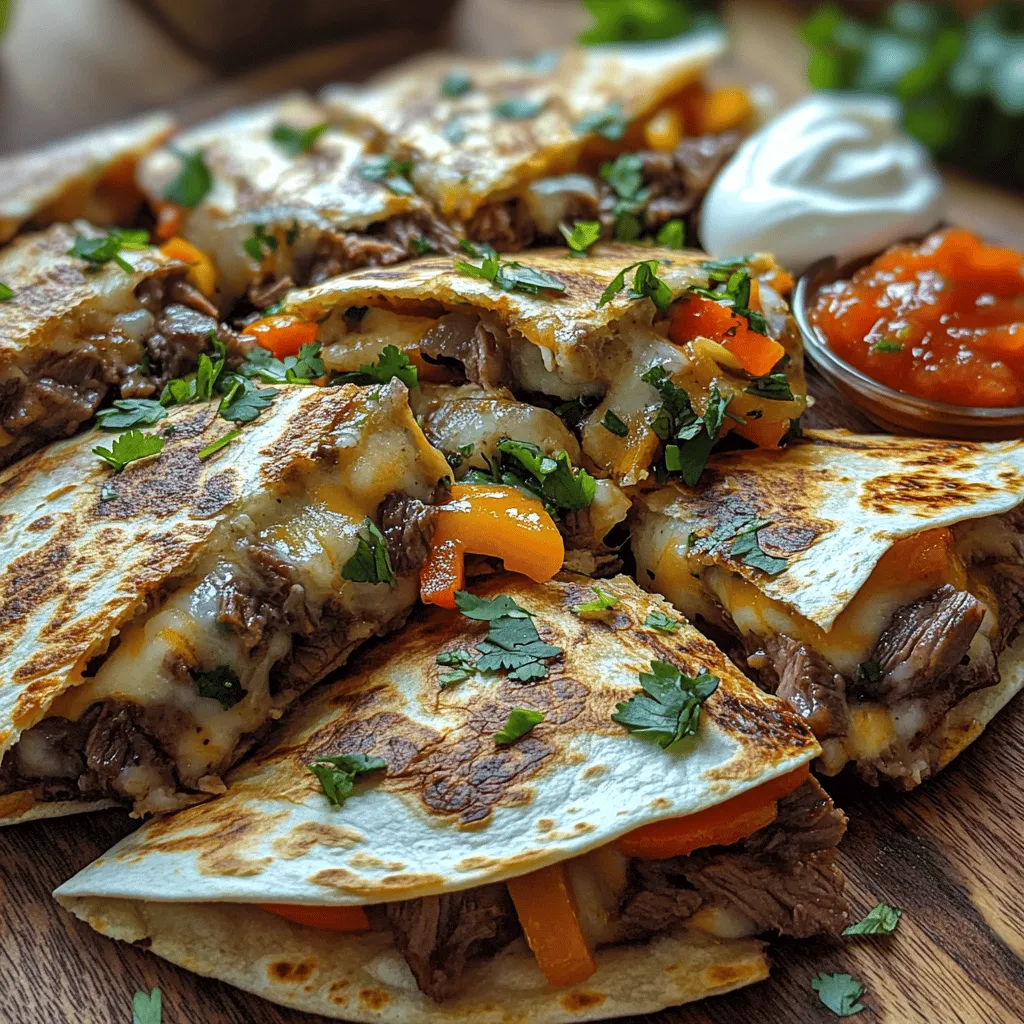Introduction
Loaded Steak & Cheese Quesadillas are more than just a meal; they are a celebration of flavors, textures, and culinary creativity. Imagine juicy, marinated flank steak, sautéed peppers and onions, and a melty blend of cheeses all encased in a warm, soft tortilla. This dish perfectly balances savory, cheesy, and fresh ingredients, making it a versatile option for any occasion. Whether you’re hosting a game day gathering, preparing a family dinner, or simply craving something delicious, these quesadillas are bound to impress.
The roots of quesadillas trace back to Mexico, where they first emerged as simple tortillas filled with cheese. Over time, the dish has evolved, incorporating various fillings and flavors that reflect regional preferences and modern culinary trends. Today, Loaded Steak & Cheese Quesadillas embrace this evolution by combining rich, tender steak with a vibrant medley of vegetables and creamy cheeses. This recipe is a testament to how simple ingredients can come together to create a mouthwatering dish that will delight your family and friends alike.
In this article, we will guide you through the step-by-step process of crafting these cheesy delights, explore variations to suit different tastes, and provide insights into the nutritional benefits of the ingredients used. Get ready to dive into a culinary journey that will elevate your cooking game and satisfy your cravings!
—
Understanding the Ingredients
To create the perfect Loaded Steak & Cheese Quesadillas, it’s essential to start with high-quality ingredients. Each component plays a vital role in the overall flavor and texture of the dish. Let’s break down the core components that make these quesadillas irresistible.
Flank Steak
The star of this recipe is undoubtedly the flank steak. Known for its rich flavor and tenderness when cooked properly, flank steak is an excellent choice for quesadillas. It has a robust beefy taste that pairs beautifully with the other ingredients. When preparing your flank steak, look for a piece that is bright red with minimal fat. This cut benefits from marinating, which enhances its flavor and tenderness.
Cheese Varieties
For the ultimate cheesy experience, we recommend a blend of Monterey Jack and cheddar cheese. Monterey Jack melts beautifully, adding creaminess to each bite, while sharp cheddar offers a delightful tang that elevates the overall flavor profile. Feel free to experiment with other cheese varieties such as pepper jack for a spicy kick or mozzarella for a gooey texture.
Vegetables
Fresh vegetables add both flavor and nutrition to your quesadillas. In this recipe, we will use bell peppers and onions. Bell peppers bring sweetness and a pop of color, while onions add depth and savory notes. These vegetables not only enhance the taste but also contribute valuable nutrients, making your quesadillas a balanced meal. If you’re looking to mix things up, consider adding mushrooms, spinach, or even zucchini for added texture and flavor.
Tortillas
The foundation of any quesadilla is the tortilla. For this recipe, large flour tortillas are ideal as they provide the perfect vessel for holding the generous filling of steak, cheese, and vegetables. Flour tortillas are soft, pliable, and create a delightful chewy texture once cooked. If you prefer a healthier option, whole wheat or corn tortillas can also work well.
—
Marinating the Steak
The importance of marinating your flank steak cannot be overstated. A good marinade not only infuses the meat with flavor but also helps to tenderize it, resulting in a more enjoyable eating experience.
How the Marinade Enhances the Flavor Profile
A well-crafted marinade typically contains an acid (like lime juice or vinegar), oil, and various seasonings. The acid helps to break down the muscle fibers in the meat, making it more tender. At the same time, the oil adds moisture, while the spices contribute depth and complexity to the flavor. For our Loaded Steak & Cheese Quesadillas, a marinade with lime juice, garlic, cumin, and a touch of chili powder works wonders in bringing out the best in flank steak.
Recommended Marinating Time for Optimal Results
For the best results, allow the steak to marinate for at least 30 minutes, though 2 to 4 hours is ideal. If you have more time, marinating overnight in the refrigerator will yield even more flavorful results. Just be sure to keep the steak covered and stored properly to maintain its quality.
Tips for Selecting and Preparing Flank Steak
When selecting flank steak, look for a piece that has a bright red color with minimal visible fat. Flank steak can be tough if not cooked correctly, so it’s essential to slice it against the grain after cooking to ensure tenderness. To prepare the steak, pat it dry with paper towels before marinating. This helps to achieve a good sear when cooking, creating a flavorful crust on the outside.
—
Sautéing Vegetables to Perfection
The vegetables in your quesadillas play a crucial role in developing layers of flavor. Sautéing bell peppers and onions enhances their natural sweetness and adds a caramelized depth that complements the savory steak.
The Role of Sautéing in Developing Flavors
Sautéing is a cooking technique that involves cooking food quickly in a small amount of oil over medium-high heat. This method allows the vegetables to soften and develop a beautiful golden color, creating a rich flavor profile. For this recipe, we’ll sauté the bell peppers and onions until they are tender and slightly caramelized, which will add a delightful sweetness to the quesadillas.
Best Practices for Achieving Caramelization
To achieve the best caramelization, consider the following tips:
– Use the Right Pan: A heavy-bottomed skillet or cast-iron pan retains heat well, allowing for even cooking.
– Don’t Overcrowd the Pan: Cooking vegetables in batches if necessary ensures that they sauté rather than steam. Overcrowding leads to moisture buildup, which hinders caramelization.
– Be Patient: Allow the vegetables to cook without stirring too frequently. Give them time to develop color and flavor.
Variations: Alternative Vegetables to Consider
While bell peppers and onions are classic choices, feel free to get creative with your vegetable selection. Some fantastic alternatives include:
– Mushrooms: Their earthy flavor pairs well with steak.
– Spinach: For a nutrient boost, add fresh spinach towards the end of cooking.
– Zucchini: Sliced zucchini adds a nice texture and mild flavor.
—
Cooking the Steak
Once your flank steak has marinated, it’s time to cook it to perfection. Achieving the right doneness is crucial for a flavorful and tender result.
Techniques for Cooking Flank Steak in a Skillet
To cook flank steak in a skillet, follow these steps:
1. Preheat the Skillet: Heat a tablespoon of oil in a heavy skillet over medium-high heat until shimmering. This ensures a good sear.
2. Remove Excess Marinade: Take the steak out of the marinade and let any excess drip off. This prevents burning and allows for better browning.
3. Cook the Steak: Place the steak in the hot skillet and cook for about 4-5 minutes on each side for medium-rare, depending on the thickness. Aim for an internal temperature of 130°F to 135°F.
4. Rest the Meat: Once cooked, remove the steak from the skillet and let it rest for at least 5 minutes before slicing. Resting allows the juices to redistribute, making the steak more succulent.
Understanding Different Doneness Levels and How They Affect Flavor
Flank steak is best enjoyed medium-rare to medium so that it remains tender and juicy. Here are the temperature ranges for different doneness levels:
– Rare: 120°F – 125°F (cool red center)
– Medium-Rare: 130°F – 135°F (warm red center)
– Medium: 140°F – 145°F (pink center)
– Medium-Well: 150°F – 155°F (slightly pink center)
– Well Done: 160°F and above (no pink)
Tips for Resting Meat After Cooking
Resting is a crucial step that many people overlook. After removing the steak from the heat, tent it loosely with aluminum foil and let it rest. This helps to keep the steak warm while allowing the juices to settle, resulting in a more flavorful bite.
—
Assembling the Quesadillas
With your steak cooked and your vegetables sautéed, it’s now time to assemble your Loaded Steak & Cheese Quesadillas. The layering process is key to ensuring each bite is packed with flavor and texture.
Layering for Maximum Flavor and Texture
1. Start with the Tortilla: Lay a large flour tortilla flat on a clean surface or a cutting board.
2. Add Cheese: Sprinkle a generous layer of shredded cheese on half of the tortilla. This acts as the “glue” to hold everything together.
3. Layer the Ingredients: Top the cheese with a portion of the sautéed vegetables, followed by slices of the cooked flank steak. Add another layer of cheese on top to ensure the quesadilla holds together when cooked.
4. Fold and Cook: Carefully fold the tortilla in half, pressing down gently to compact the filling. Place the quesadilla in the skillet over medium heat and cook until the tortilla is golden and crispy, and the cheese is melted, about 3-4 minutes per side.
By following these steps, you’ll create a quesadilla that is not only packed with flavor but also visually appealing. The contrast of the crispy tortilla against the gooey cheese and savory filling is sure to make your mouth water.
As you embark on this culinary adventure, prepare to indulge in the deliciousness of Loaded Steak & Cheese Quesadillas. With their rich flavors and satisfying textures, they are bound to become a staple in your recipe repertoire.

The Ideal Cheese-to-Filling Ratio
When it comes to crafting the ultimate loaded steak and cheese quesadilla, achieving the perfect cheese-to-filling ratio is crucial for flavor and texture. A general guideline is to aim for a 1:2 ratio of cheese to steak and vegetables. This means for every cup of mixed steak and veggies, you should use about half a cup of cheese. This balance ensures that every bite is creamy and satisfying without overwhelming the other ingredients.
Using a combination of cheeses, such as sharp cheddar for flavor and mozzarella for meltiness, can elevate your quesadilla experience. Mixing cheeses can also create a more complex flavor profile, enhancing the overall dish. Don’t hesitate to experiment with your preferred cheese types to find the ideal combination that suits your palate.
Techniques for Folding and Cooking Qesas Evenly
Folding and cooking your quesadillas evenly is essential to achieving that perfect golden crust and gooey filling. Here are some techniques to ensure your quesadillas turn out beautifully:
1. Folding: Begin by placing your filling on one half of a tortilla, leaving a small border around the edge. This will help prevent the fillings from spilling out while cooking. Carefully fold the tortilla over the filling, pressing gently to seal it.
2. Cooking: Preheat your skillet over medium heat. A well-heated skillet is key to achieving that crispy exterior. Use a non-stick skillet or a well-seasoned cast-iron pan to prevent sticking.
3. Pressing: Once the quesadilla is in the skillet, use a spatula to press down gently. This will help the cheese melt evenly and the tortilla crisp up.
Cooking the Quesadillas
Mastering the Quesadilla Cooking Process
Optimal Skillet Temperature for Achieving a Golden Crust
The ideal temperature for cooking quesadillas is medium to medium-high heat. If your skillet is too hot, the tortillas may burn before the cheese has a chance to melt. Conversely, cooking on too low a heat can lead to a soggy quesadilla. A good rule of thumb is to preheat your skillet for about 5 minutes before adding the quesadilla.
Timing Tips for Flipping and Ensuring Even Cooking
Cooking time for quesadillas typically ranges from 3 to 5 minutes per side. To flip the quesadilla, carefully slide a spatula underneath and lift it slightly. If the underside is a rich golden brown, it’s time to flip. If it’s pale or soft, give it another minute or two.
After flipping, press down gently with the spatula to ensure good contact with the skillet. This will help the cheese melt properly and the tortilla crisp up evenly.
How to Tell When the Quesadilla is Perfectly Done
A perfectly cooked quesadilla should be golden brown and slightly crispy on both sides. The cheese inside should be fully melted and gooey, while the filling should be heated through. You can check the cheese by gently lifting a corner of the quesadilla; if it stretches, it’s ready to be removed from the heat. Once cooked, let the quesadilla rest for a minute before slicing. This will allow the cheese to set slightly, making it easier to cut and serving a mess-free experience.
Serving Suggestions
Enhancing Your Quesadilla Experience
To elevate your loaded steak and cheese quesadilla, consider these serving suggestions:
1. Ideal Accompaniments: A dollop of sour cream and a side of salsa are classic choices that complement the richness of the quesadilla. Guacamole can also add a creamy texture and fresh flavor.
2. Garnishing Options: Adding fresh cilantro, diced tomatoes, or sliced green onions on top can provide a burst of color and freshness. A squeeze of lime over the quesadilla before serving can enhance the flavors remarkably.
3. Pairing Ideas: For a complete meal, serve your quesadillas with a side of Mexican rice or a simple salad. Beverage pairings like a refreshing margarita, a light beer, or even a homemade horchata will complement the flavors of your dish beautifully.
Nutritional Benefits of Ingredients
Healthy Aspects of Loaded Steak & Cheese Quesadillas
Loaded steak and cheese quesadillas not only satisfy your taste buds but also provide nutritional benefits:
1. Nutritional Breakdown of Steak: Steak is an excellent source of protein, which is essential for muscle repair and growth. It provides important nutrients such as iron, zinc, and B vitamins that support energy levels and overall health.
2. Benefits of Including Vegetables in Your Diet: Adding vegetables to your quesadilla not only boosts flavor but also increases fiber, vitamins, and minerals. Bell peppers, onions, and spinach can add color and nutrition, making your dish more balanced.
3. The Role of Cheese in a Balanced Meal: While cheese does contain fats, it also provides calcium and protein. Choosing moderate amounts of cheese can contribute to a balanced meal, especially when paired with other nutritious ingredients like vegetables and lean protein.
Variations on the Recipe
Tailoring Loaded Steak & Cheese Quesadillas to Your Taste
While the classic loaded steak and cheese quesadilla is fantastic, don’t hesitate to tailor it to your taste:
1. Vegetarian Alternatives: For a meat-free option, consider using portobello mushrooms or tofu as a protein substitute. Both options absorb flavors well and can be seasoned similarly to beef.
2. Spicy Kick: If you enjoy heat, incorporate jalapeños or a spicy pepper jack cheese into your filling. This adds a layer of flavor and spice that elevates the dish and caters to those who love a little kick.
3. Gluten-Free Options: For those avoiding gluten, corn tortillas are an excellent alternative. They offer a different flavor and texture while maintaining the integrity of the quesadilla.
Conclusion
Loaded steak and cheese quesadillas are not just a meal; they are a culinary experience that brings flavor, comfort, and creativity to your dining table. By mastering the steps outlined in this article, you can create a dish that is not only satisfying but also adaptable to various dietary preferences and occasions. Whether enjoyed as a casual snack or a centerpiece for a gathering, these quesadillas are sure to leave a lasting impression. Embrace the joy of cooking and the satisfaction of sharing delicious food with loved ones. Transform your kitchen into a haven of flavor and creativity with these loaded quesadillas, and watch as they become a staple in your culinary repertoire.

